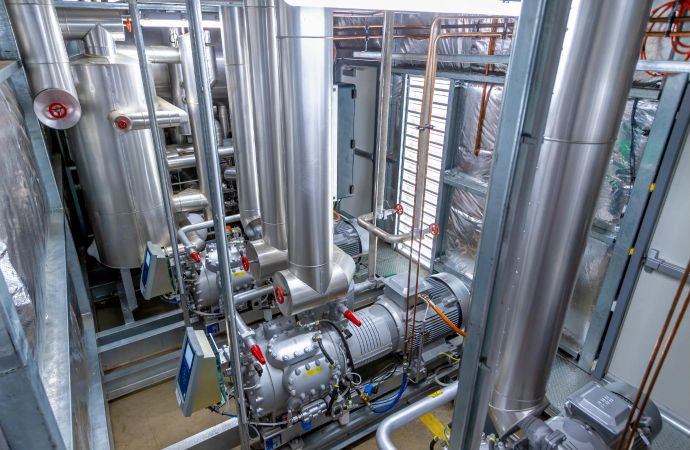The low-charge trend is attracting new customers to ammonia, while new technology is bringing CO2 to higher capacities. All this innovation is helping industry to phase down synthetic refrigerants and improve energy efficiency. Accelerate Australia & NZ reports.

ScanPAC engine room for a Scantec central-style, low-charge NH3 plant installed in October in Mackay, North Queensland.
Photo credit: Marty Pouwelse Photography
Ammonia's superior performance as a heat transfer substance for use in large industrial-sized refrigeration plants, compared to synthetic refrigerants, is already well known.
"Ammonia has a low boiling point [...] and a high latent heat of vaporisation eight times higher than R12 and six times higher than R134a," says HVAC&R industry body ASHRAE in its position paper on ammonia (NH3) as a refrigerant.
This is one reason why ammonia is the only natural refrigerant that has been consistently in use since the emergence of modern refrigeration technology in the mid-1800s.
According to the International Institute of Ammonia Refrigeration (IIAR), NH3 was first used as a refrigerant in the 1850s, in France.
Yet as demand for industrial refrigeration grew, so did the amount of ammonia used in refrigeration systems.
As Terry L. Chapp of the International Association of Refrigerated Warehouses put it in a 2014 white paper, "for decades, refrigeration was regarded by many as simply the cost of doing business and the dictum was often, 'just make sure it’s cold'".
"With this perspective as a backdrop, both facilities and refrigeration systems grew dramatically in size. Accompanying the growth of the refrigeration system was a consequent growth in the ammonia charge of the facility," Chapp wrote.
Worldwide, the HFC phasedown taking place under the Kigali Amendment to the Montreal Protocol – as well as the drive to save costs by improving energy efficiency – is triggering renewed interest in natural refrigerant-based systems for industrial refrigeration.
The rise of low-charge ammonia systems – and the proliferation of transcritical CO2 systems – is therefore timely as Australia’s industrial refrigeration sector begins to adopt energy-efficient alternatives to HFCs.
Riding the low-charge ammonia wave
Smaller amounts of ammonia are now being used without compromising on energy efficiency.
In October, for example, Scantec Refrigeration Technologies commissioned a central-type, two-stage and low-charge ammonia system in Mackay, North Queensland.
The ammonia plant serves a cold storage and food service distribution facility and is notably, "the smallest low-charge central system designed and constructed by Scantec so far," according to the firm’s managing director, Stefan Jensen.
The system's low- and medium-temperature design capacities are both approximately 50 kW respectively, with a total ammonia charge of 500 kg.
Competition between natural refrigerants in this area is growing. "The capacity range is well and truly within the area previously reserved for HFC-based solutions and is now occupied by a large number of transcritical CO2 solution providers," says Jensen.
The Mackay installation replaced an R404A system that was over a decade old, "comprising multiple air-cooled, single compression stage, multiplexed condensing units, and electric defrost," Jensen says.
"It is believed to be the first 'real' HFC-based system being replaced with a small-scale low charge NH3 system in Australia – and possibly anywhere," he notes.
Currently the system is still in an early phase of operation. At the time of going to be press, adjustments were to be made after receiving just over a month's worth of operational data.
Jensen expects actual energy performance data to soon become available in order to compare the new low-charge NH3 system to the previously installed R404A one.
This "will enable a simple 'before' vs. 'after' comparison because the plant owner remains the same and the activities conducted in the warehouse remain unchanged before and after the conversion," Jensen says.
"The plant is located in tropical North Queensland where transcritical CO 2-based solutions will struggle to deliver acceptable energy efficiencies regardless of the number of energy-efficiency measures that are added," he says.
Jensen expects to be able to analyse the recorded energy consumption figures sometime next year.
Reducing the ammonia charge in this way, combined with the superior energy efficiency of these systems compared to their HFC-based counterparts, is driving interest and innovation in these new ammonia systems, according to Jensen.
Describing Scantec's own central-style, low-charge ammonia systems at this year’s ATMOsphere Asia conference, held by Accelerate publisher shecco in Singapore in September, Jensen said, "the ammonia charge in the freezer evaporators is so low that in the event of one evaporator emptying itself completely, the ammonia concentration in the freezer can never ever exceed 100 ppm – which is way, way below the IDLH value". IDLH refers to the concentration above which the ammonia becomes 'Immediately Dangerous to Life or Health'.
Arguing that their energy efficiency is driving uptake of these systems, Jensen says, "low-charge ammonia is by far superior to HFCs, transcritical CO2, single-staged economised ammonia with liquid overfeed, or any other concept. This is based on energy performance records that have been measured in a real-life warehouse".
CO2 scaling up
As for CO2, many companies see significant market opportunities for this natural refrigerant to be used more widely in industrial applications, thanks both to the generally lower cost of CO2 systems compared to their comparable ammonia counterparts, and their ability to provide significant amounts of heat reclaim.
This is an exerpt from 'Industrial refrigeration: A competitive market', which appeared in the spring 2018 issue of Accelerate Australia & NZ.
For the full story, click here.
Related stories



